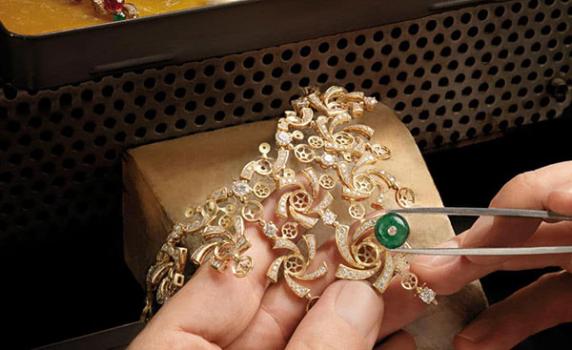What do Jewelry Designers do? Where do Jewelry Designers work? FS takes a look:

Jewelry designers create accessories that may be made of anything from plastic to pearls to precious stones. Jewelry designers work in a variety of environments from small kiosks to massive diamond manufacturing firms. While the talent and skills of a jewelry designer can be used in a number of manufacturing or retail environments, many designers choose to work independently by selling their designs door-to-door, directly to retailers, or at their own shops.
Jewelry Designer Job Description:
Jewelry designers create adornments for the ears, nose, wrists, fingers, and ankles. Some jewelry designers also create hair accessories from pearls, jewels, and other stones. They may create exclusive, one of a kind handmade jewelry or they might use special equipment to design and produce jewelry.
Many jewelry designers have their own lines or produce pieces on spec for jewelry stores, retail shops, accessories stores, boutiques, and others. Some jewelry designers work exclusively for diamond jewelers, costume jewelers, or manufacturing companies. However, a number of jewelers create pieces (part-time) and sell them in a variety of environments from farmer’s market’s, fairs, and festivals to kiosks at the mall or on the boardwalk.
Becoming a Jewelry Designer:
If you plan to work for a jewelry manufacturer, design studio, retailer or boutique, you must have formal training. Most employers prefer a bachelor’s degree in art or fashion design. For entry-level designers, experience through an internship, apprenticeship, or paid position is preferred. Retail experience is acceptable as well as marketing or sales, as long as you have a degree and the solid design skills.
For self-employed jewelry designers, sales, business, and marketing skills are a must. To make a comfortable salary, you will have to promote your wares to jewelry stores, boutiques, fabric companies, apparel companies, and large retailers. If you plan to open your own accessories boutique, these skills are an even greater asset because you will have to sell your designs to customers on a daily basis, while making sure your shop runs like a well-oiled machine.
Jewelry Designer Salaries:
alaries for jewelry designers vary greatly. An independent jewelry designer just starting out can earn as little as several thousand dollars a year, while top-level designers can earn several thousand dollars per year. The Bureau of Labor Statistics does not report salary information for jewelry designers. Fortunately, the closest relative of a jewelry designer is a fashion designer.
The Bureau offers a significant amount of information about fashion designers. Earnings and projections for fashion designers may give you an idea of what a jewelry designer can make depending on experience, size and type of company, and geographic location. For example, some of the highest paid fashion designers live in fashion capitals such as Los Angeles ($74,180 per year), New York ($81,540), and Miami ($67,920). Median annual wages for salaried fashion designers were $61,160 in May 2008. The middle 50 percent earned between $42,150 and $87,120 and the lowest 10 percent earned less than $32,150. The highest 10 percent earned more than $124,780.
Job Trends for Jewelry Designer:
Job prospects for both salaried and self-employed jewelry designers are fair, but success in this industry depends on determination and self-motivation. Designers that put in the time and make a name for themselves will have the best job prospects. Establishing yourself in the jewelry design business takes time, so patience is important, but the rewards are truly great. Once you’ve reached this level, you will have no problems securing a staff position, should you choose to work for a company instead of opening your own business.
Fashion designers overall can expect a 1 percent increase in employment for the 2008-2018 decade. Major fashion New York, Los Angeles, Las Vegas, Miami, Dallas, and Atlanta. However, because jewelry can be purchased anywhere from drug stores and gas stations to grocery stores these days, manufacturing facilities can be found just about anywhere in the U.S.